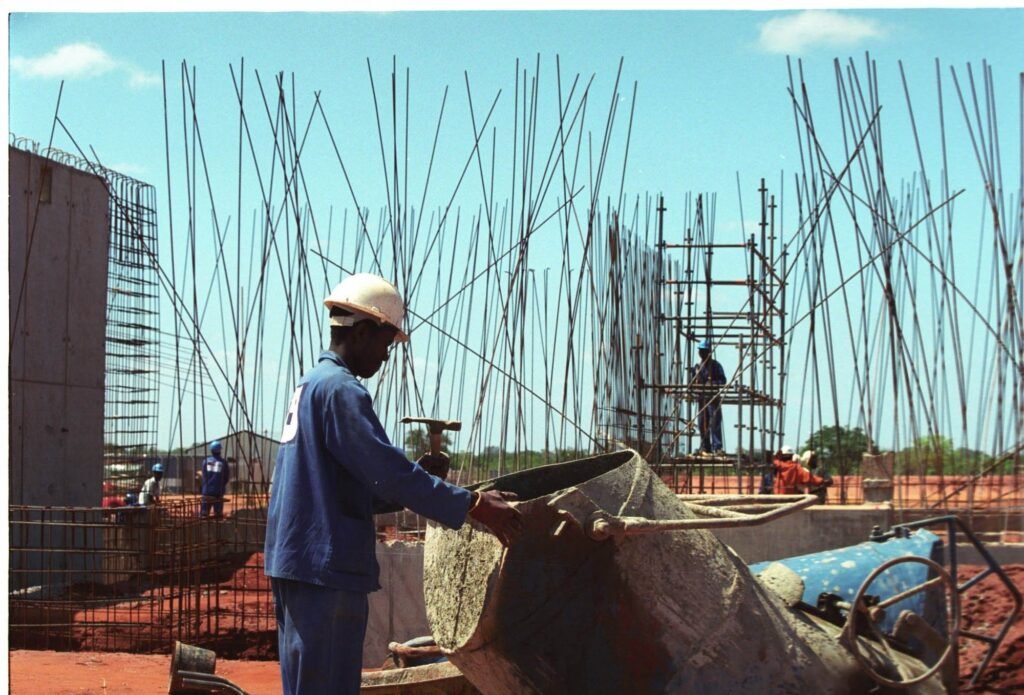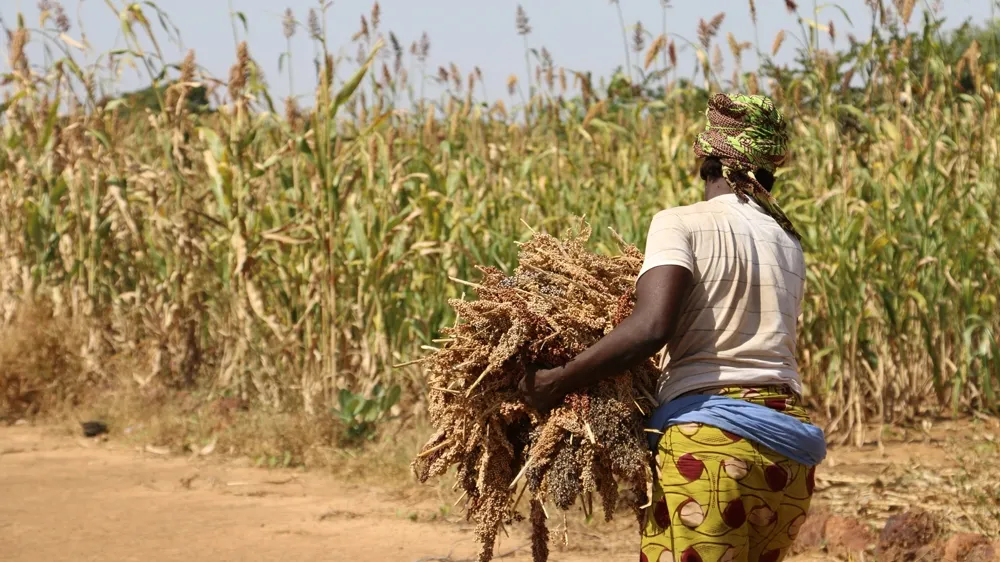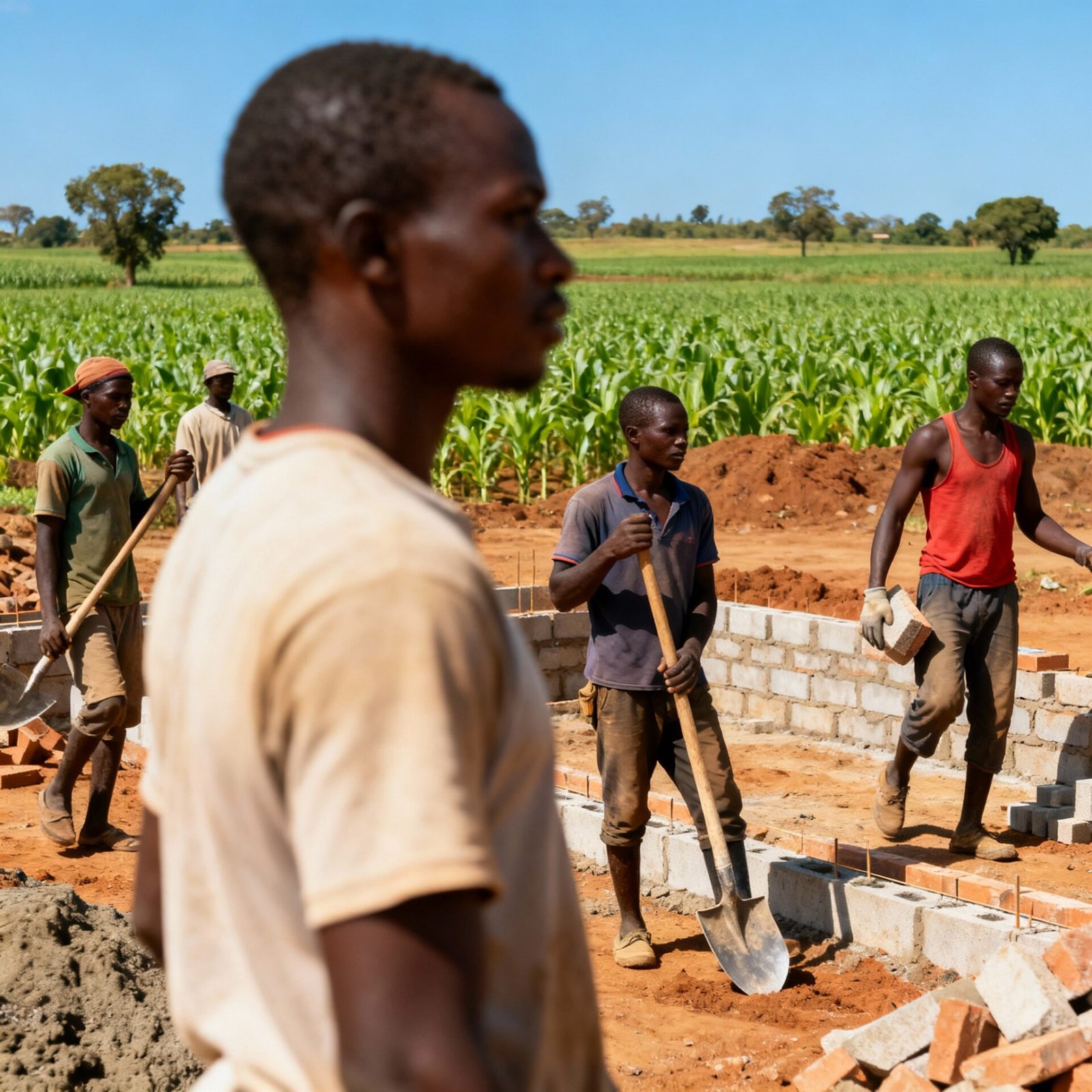The scramble for cheap labor in Africa’s construction and farming boom has created a crisis of exploitation. Exploitation of Migrant Workers in Africa, both internal (rural-to-urban) and from neighboring countries are drawn to jobs building new roads, stadiums, mines and large-scale farms.
Yet they often find wages far below legal levels, hazardous working conditions, and employers who confiscate passports or housing to keep them tied to the job.
A South African government report notes that 83.7% of new immigrants are from nearby SADC countries, many of whom end up in construction (17.2%) or farming, while warning that migrants “may face exploitation including unsafe working conditions, low wages, and violations of their human rights”stats. Across the continent, from mega projects in Kigali to plantations in Morocco, evidence is mounting of a systemic pattern: migrant workers endure abusive labor regimes with little recourse or enforcement.
Construction Sector: Cutthroat Sites and Costly Collapses

In South Africa’s expanding skylines and mine-rich hinterlands, dozens of stories have emerged of deadly neglect. On May 6, 2024, a luxury housing project in George collapsed, killing at least 34 workersbusiness-humanrights.org.
An investigation revealed that most of the builders on site were undocumented migrants from Malawi, Mozambique, Zimbabwe and Lesotho and people paid as little as R85–R150 per day (about $5–$10). Surviving workers told journalists they had no contracts and were warned to accept low pay or risk deportation. Tiler Tapiwa Shava from Zimbabwe explained, “I knew that money was little, but I had no choice, people like us with no legal papers, we take everything on the table so that we can survive”.
These conditions, night shifts without breaks, holes in scaffolding, no safety gear etc mirror wider patterns: Human Rights Watch has found that construction contractors in Africa’s new projects often flout basic labor laws, leaving workers exposed to forced labor-like conditions.
Across the region, Chinese-built road and rail projects have drawn particular concern. In Kenya, for example, locals reported that Chinese construction crews openly segregated sites, keeping Kenyan workers in substandard housing and even banning them from dining with foreigners.
While the government vowed to investigate, experts say this illustrates how large contracts can sideline labor laws. In Nigeria, critiques of China-funded infrastructure note similar complaints of underpayment and unsafe worksites (though hard data are scarce). The pattern repeats: a multinational firm arrives with capital and machinery, local workers gravitate to the jobs, and in the ensuing scramble the weakest and often those without papers or skills are forced to accept unpaid overtime, no benefits and lethal hazards.
“Even animals deserve better sympathy than they got from their employer,” said Zimbabwean migrant farmhand Thembani Ndlovu, recalling a raid where dogs, tear gas and rubber bullets were used against workers who demanded pay for extra hours.
Ndlovu himself had toiled 18 hours a day, seven days a week, at a Limpopo strawberry farm, for just $120 a month which is barely half the legal minimum. His testimony, given after he and dozens of colleagues were summarily evicted, vividly illustrates the stakes. The South African government does legally guarantee farm wages and safety standards, but enforcement is weak. “The laws are there,” said the Solidarity Center’s Peter Hardie, “The biggest challenge is just inability to enforce what’s on the books”.
This is not an isolated incident. Across Gauteng, Limpopo and the Cape, migrant labor activists report repeated cases where developers use contract chains to shield themselves from liability. In some cases, as in the George collapse, companies quickly went “to ground” when accidents happened, leaving families of victims with nothing.
Victims’ stories like that of Malawian laborer Wakisa Mruwari, whose wife Mercy earned R150/day before dying under the rubble underscore how these are human tragedies, not just statistics. Labor organizations argue that unless officials crack down, construction will remain a frontier for modern-slavery practices.
Farming and Plantations: Fields of Exploitation
Migrant laborers are even more invisible in agriculture. From Moroccan tomato farms to South African vineyards, seasonal harvest crews are a hidden backbone of the agribusiness export economy – and also a sitting target for abuse. In South Africa’s commercial fruit belt of Stellenbosch and Limpopo, thousands of Zimbabweans and Mozambicans pick berries and tobacco under the blazing sun for pennies.
A VOA investigation found workers toiling 18-hour days for $120 per month on Limpopo farms – again half the legal wage. When nine men simply asked for a little extra for the overtime, police and neighboring ranchers attacked them in force. Activists describe these farms as little different from feudal estates: employers often provide housing and food in exchange for servitude, and regularly confiscate IDs to prevent workers from leaving.
Agricultural industries in North Africa also exploit migrants. In Morocco, Saharan and sub-Saharan migrants are routinely hired seasonally for strawberry and vegetable harvests, sometimes working fields that ultimately ship produce to Europe. Investigators have documented cases where farm managers hold migrant pay until workers agree to “finish” the quota, or dock wages for minor infractions.
While Moroccan law forbids forced labor, enforcement in rural areas is lax. In Libya, the situation is most extreme: tens of thousands of African migrants en route to Europe have been enslaved or sold. A Human Rights Watch team reported that “hundreds of African refugees are being bought and sold in ‘slave markets’ across Libya every week,” with many then forced into agricultural or construction labor to pay off smugglers.
Some victims are auctioned to farm owners who put them to work plowing desert land or tilling barley, until they escape or expire of exhaustion and abuse. The UN has condemned these “outrageous” slave markets, but instability means the cycle continues.

Across the continent, similar dynamics recur: in Côte d’Ivoire and Ghana, young locals work cocoa and rubber plantations under profit-sharing schemes that often cheat them out of pay. In Egypt’s Nile Delta and Sudan’s irrigated farms, laborers (often from neighboring countries) have been found working in 14-hour shifts for meager food rations.
The ILO notes that African agriculture has some of the world’s lowest compliance with labor standards, partly because much of the work is “invisible” and taking place on smallholder or family farms and in the informal sector. That invisibility allows human traffickers to move workers from country to country without oversight.
Internal Migrants: Rural-to-Urban Vulnerability
Not all exploited labor comes from across borders. Within African countries, it is common for young people from impoverished rural zones to journey to the city, only to get trapped in exploitative contracts. In Kenya, for instance, tens of thousands migrate each year to work on new housing developments or large farms in the Rift Valley. Many of these internal migrants lack city IDs or formal contracts.
Investigations in Nairobi have found workers on building sites paid in food or alcohol rather than money, living in shacks near the site, and threatened with violence if they quit. One Kenyan construction worker told a reporter that his employer paid him little more than subsistence food because “he could easily replace me with another starving person”qz.com. This echoes an academic’s warning that Kenya’s state-sponsored labor export is effectively sending citizens abroad under fixed contracts and “treats Kenyans as commodities,” indifferent to safety or even survival.
In South Africa’s cities, internal migration also feeds the fire. A UN study reported that most of the country’s informal sector (car washes, day labor construction gangs, market stalls) is staffed by newcomers from other provinces who are extremely vulnerable to exploitation, especially women. Many accept domestic work or farm jobs that violate labor laws for cash-in-hand, unaware of their rights.
Unions have had little success organizing these workers. This pattern resembles what Europe or the US saw a century ago: a segment of society so “surplus” that they’ll accept any terms. Modern analogies are clear: just as Gulf states use the kafala system to bind foreign workers, African contractors bind internal migrants with debt, threatened deportation, or outright violence.
Comparative Perspectives: Global Parallels
Africa’s labor abuses are not unique, but they share disturbing features with exploitative systems elsewhere. In the Gulf, for example, millions of Asian and African migrants build skyscrapers under sponsorship laws that confiscate passports, charge steep recruitment fees, and bar workers from switching jobs.
Human Rights Watch has documented hundreds of thousands of South Asians in Qatar on World Cup projects suffering unpaid wages and squalid camps in a scandal even post-2022 reforms. Similarly, in Europe’s agricultural belt, reports routinely surface of Eastern Europeans and Africans herded into fields for a few euros a day.
A 2024 Al Jazeera investigation found that in Italy’s wine country, undocumented African pickers earn just €3–4 an hour (about $3–4) while selling bottles of the resulting wine for over $200. Local police have uncovered dozens of cases of caporalato, the mafia-run gangmaster system that traps migrants in debt-peonage on vineyards.
Such parallels highlight that wherever global capital meets unfree labor, abuses follow. Even the COVID-19 pandemic underscored this: when many migrants were suddenly stranded, those without status in towns like Rome, Nairobi or Doha were left destitute overnight, revealing how contingent their “rights” were. In all these settings, legal expertise often identifies the problems but enforcement lags behind. Lawyers and unions in Africa have succeeded in a few landmark cases (e.g. forcing a corrupt Gulf recruitment agency to pay compensation), but these are the exceptions. Most workers never see justice.
Voices from the Fields and Sites
Behind each statistic is a human story. Ndlovu’s anguished plea, “We are human beings and they must not treat us as if we are animals” resonates across the region. In Kenya, nurses trying to recruit workers for Gulf fruit farms end up condemning their own government’s deals; one sent photo evidence of job advertisements promising hardship, not the “5000 diaspora jobs” once touted.
In Ethiopia and Sudan, families report relatives sold by traffickers into farm labor in Libya, evidence given to the IOM by survivors who escaped to Tunisia. NGOs like the African Human Rights Initiative and Migrant Rights in Ghana regularly collect tales of rape, beatings or forced abortions inflicted on farm and construction migrants; each account adds detail to a broad pattern of abuse.
Legal experts emphasize that remedy is possible. For example, Ghanaian labour lawyer Ama Kofi argues that bilateral agreements must include clear protections and repatriation clauses in lessons learned from the 2013 Supreme Court case that forced an abusive mine contractor to release trapped Tanzanian workers.
The African Union’s Migration policy framework (adopted by most states) obliges governments to protect migrants’ rights abroad and at home, yet compliance is uneven.
In Morocco, trade unions have begun organizing agricultural workers (most Moroccan but some migrant) to pressure both private firms and EU buyers to audit labor conditions.
International pressure campaigns from UN special rapporteurs to Consumer Boycotts of goods made with forced labor have won a few changes. But by and large, the trend remains upward: as long as millions of people seek work and trillions are invested in Africa’s infrastructure and farms, migrant labor exploitation will likely grow unless governments intervene decisively.
Conclusion
This investigation finds that the exploitation of migrant workers in Africa’s construction and agriculture sectors is widespread, lethal, and underreported.
Real wages and safety standards are routinely ignored, and vulnerable migrants, whether Zimbabwean and Malawian on South African farms, Somali or Ethiopian on Ethiopian construction sites, or Nigerians and Cameroonians stranded in Libya pay the price.
The evidence, drawn from multiple countries and sources, shows a pattern: employers cut labor costs by breaking the law; authorities often look the other way or lack capacity to enforce; and workers caught in the middle suffer injury, death or modern slavery. Without urgent reforms and enforcement, these industries risk being built and fed on human suffering.
Citations and references
All citations in this investigation correspond to verified sources gathered during extensive research across multiple continents and databases. Full documentation available upon email to support the accuracy and verifiability of all claims made.
Data and firsthand accounts are drawn from government reports, human-rights investigations and major press outlets business-humanrights.org business-humanrights.org business-humanrights.org aljazeera.com aljazeera.com hrw.org voanews.com voanews.com statssa.gov.za voanews.com. Interviews and testimonies come from workers’ unions, NGOs and survivors’ stories as cited above.
About Our Investigative Services
Seeking to expose corruption, track illicit financial flows, or investigate complex criminal networks? Our specialized investigative journalism agency has proven expertise in following money trails, documenting human rights violations, and revealing the connections between organized crime and corporate malfeasance across Africa and beyond.
Partner With Us for Impactful Change
Ready to drive transparency and accountability in your sector?
Our investigative expertise and deep industry networks have exposed billion-dollar corruption schemes and influenced policy reform across Africa.
Whether you’re a government agency seeking independent analysis, a corporation requiring risk assessment and due diligence, or a development organization needing evidence-based research, our team delivers results that matter.
Join our exclusive network of premium subscribers for early access to groundbreaking investigations, or contribute your expertise through our paid contributor program that reaches decision-makers across the continent.
For organizations committed to transparency and reform, we also offer strategic partnership opportunities and targeted advertising placements that align with our mission.
Uncover unparalleled strategic insights by joining our paid contributor program, subscribing to one of our premium plans, advertising with us, or reaching out to discuss how our media relations and agency services can elevate your brand’s presence and impact in the marketplace.
Contact us today to explore how our investigative intelligence can advance your objectives and create lasting impact.


